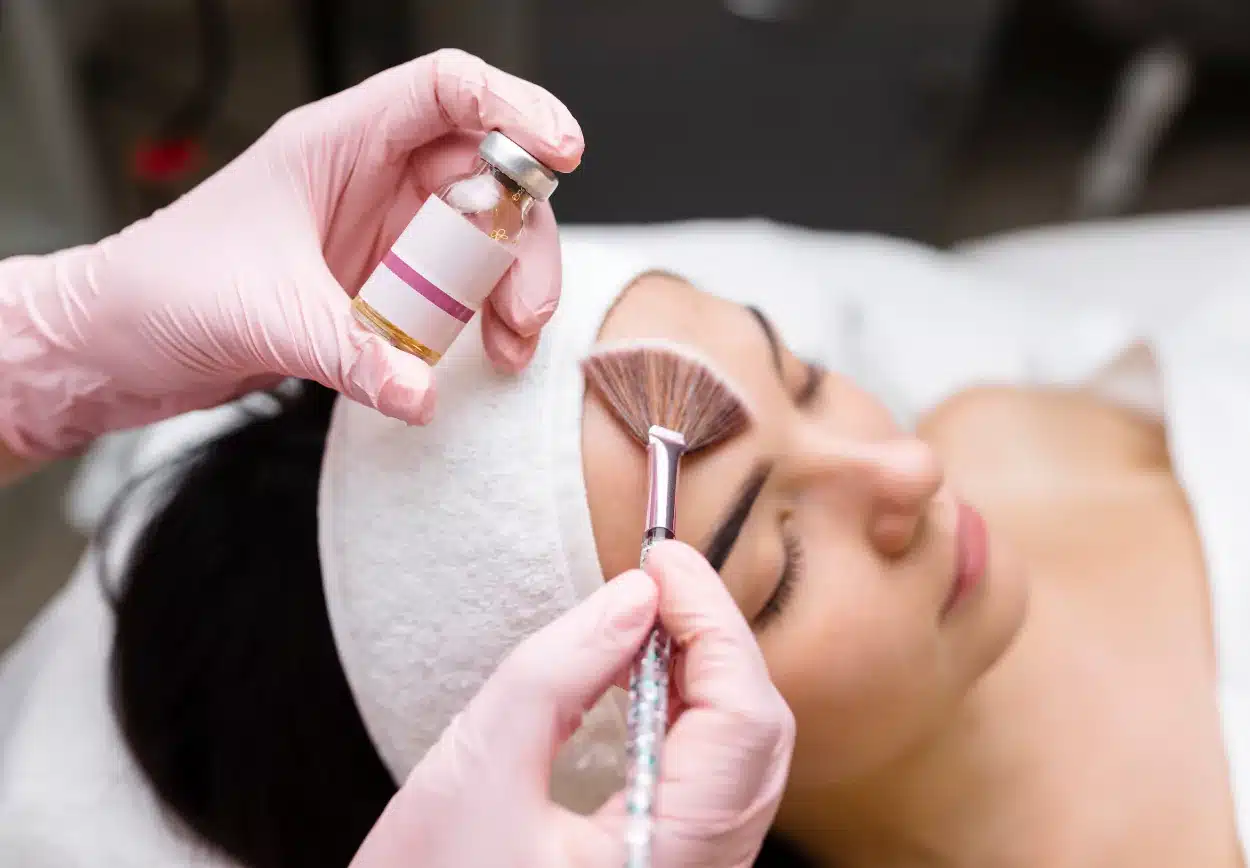You’re consistent with your skincare. You use your SPF. You stay hydrated. And yet, something feels…off. Maybe your skin looks dull no matter how much you exfoliate. Maybe fine lines are settling in where there used to be none. Maybe years of sun exposure are finally catching up.
If this sounds familiar, a chemical peel might be exactly what your skin needs to reset and rejuvenate.
Despite the rise of lasers, microneedling, and radiofrequency devices, chemical peels remain one of the most effective, time-tested tools in aesthetic medicine, especially for women in their 30s to 50s navigating changes in skin tone, texture, and elasticity.
What Is a Chemical Peel?
A chemical peel is a skin resurfacing treatment that uses a customized blend of acids to gently or deeply exfoliate the outermost layer of the skin. This controlled exfoliation reveals fresher, smoother, more even-toned skin beneath the surface while jumpstarting your body’s own collagen production.
Peels can be light, medium, or deep depending on your skin’s needs.
They are often used to address:
- Sun damage
- Hyperpigmentation or melasma
- Fine lines and wrinkles
- Dull or uneven skin tone
- Acne scars
- Enlarged pores
Think of it as a “press reset” button for your complexion, without the need for surgery or intensive downtime.
Why Women in Their 30s–50s Love Peels
As we age, our natural skin cell turnover slows down. In your 20s, this process happens roughly every 28 days. By your 40s or 50s? It can take up to 45–60 days. That’s why skin starts to look duller, drier, or more uneven—your old skin cells are just hanging out too long.
Chemical peels work by speeding up that turnover process. You’ll shed the older, damaged cells and make room for newer, smoother ones. Plus, deeper peels can stimulate collagen remodeling, which helps firm the skin and reduce the look of fine lines and creases.
Types of Chemical Peels
Chemical peels are not one-size-fits-all. At Vitality Women’s Healthcare, we offer a variety of peels tailored to your skin tone, texture, and goals:
Light Peels (Superficial)
Perfect for regular maintenance, these peels use mild acids like alpha-hydroxy acids (AHAs) or glycolic acid to exfoliate the outermost layer. Great for brightening, smoothing, and preventing breakouts.
Medium Peels
These penetrate deeper into the dermal layer using trichloroacetic acid (TCA) or stronger AHAs. They’re ideal for correcting hyperpigmentation, mild scarring, and early signs of aging.
Deep Peels
Reserved for more severe sun damage, deep wrinkles, or textural irregularities, deep peels can offer dramatic results but also require more downtime and post-care. These are always done under strict medical guidance.
Benefits of Chemical Peels
- Smooths fine lines and wrinkles
- Reduces sun spots and pigmentation
- Improves skin tone and radiance
- Unclogs pores and reduces breakouts
- Firms and tightens through collagen stimulation
- Boosts the effectiveness of skincare products
Many women notice an improvement in how their makeup applies, how their skincare absorbs, and how refreshed they feel when they look in the mirror.
What to Expect During and After a Peel
Chemical peel sessions typically take about 30 minutes. You may feel some mild tingling, warmth, or stinging depending on the strength of the solution. After the treatment, your skin may appear pink or lightly flushed, and you might experience peeling or flaking over the next few days. This is normal and part of the rejuvenation process.
During recovery:
- Avoid direct sun exposure
- Use gentle, hydrating skincare
- Stay moisturized and wear SPF daily
- Avoid exfoliants, retinoids, or harsh products
Are Chemical Peels Safe for All Skin Types?

Chemical peels can be safely used on many skin types and tones, but choosing the right formula and provider is key, especially for those with melanin-rich skin or a history of sensitivity. At Vitality Women’s Healthcare, our experienced aesthetic team evaluates your skin carefully before recommending any treatment.
How Often Should You Get a Chemical Peel?
For light peels, you can schedule treatments every 4–6 weeks for ongoing maintenance. Medium or stronger peels are typically done in a series spaced out over a few months or once or twice a year as needed.
We’ll help you design a plan based on your skin goals, lifestyle, and how aggressively you want to treat certain concerns.
Chemical Peels vs. Other Skin Resurfacing Treatments
You might be wondering: should I choose a chemical peel, microneedling, or laser treatment?
While each has its strengths, chemical peels are:
- More affordable than lasers
- Easier to tailor for various skin tones
- Excellent for both prevention and correction
- Quick with minimal downtime (especially light peels)
Many of our patients combine chemical peels (in different appointments) with treatments like RF microneedling, tox, or medical-grade skincare for even better results.
Ready to Refresh Your Skin This Season?
If your skin is looking tired, uneven, or just needs a fresh start, a chemical peel could be the perfect solution. Whether you want to target acne scars, fade sun spots, or soften fine lines, our team is here for all your beauty needs.
Schedule a consultation today for a personalized treatment plan that fits your goals and your life!




